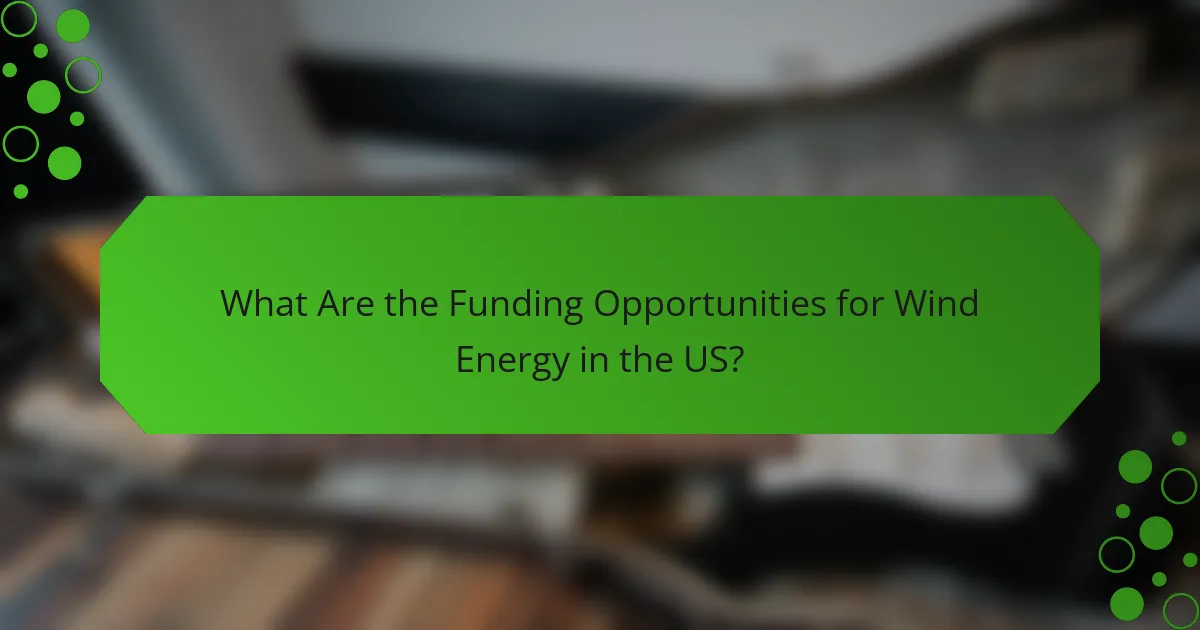Wind energy grants offer a variety of funding opportunities in the US, including federal, state, and private sector options, aimed at enhancing wind energy capacity and innovation. Eligibility typically extends to non-profit organizations, state and local governments, private companies, and educational institutions, each with specific requirements. To successfully apply for these grants, applicants must understand the criteria, prepare necessary documentation, and meet submission deadlines.

What Are the Funding Opportunities for Wind Energy in the US?
In the US, funding opportunities for wind energy include federal grants, state-specific programs, private sector funding, non-profit organization grants, and research and development funding. These options can significantly support projects aimed at increasing wind energy capacity and innovation.
Federal grants
The federal government offers various grants to promote wind energy development. Programs such as the U.S. Department of Energy’s Wind Energy Technologies Office provide funding for projects that enhance technology and reduce costs. Applicants typically need to demonstrate how their projects align with national energy goals.
Grants can cover a range of expenses, including research, development, and deployment of wind energy systems. It’s essential to stay updated on application deadlines and eligibility criteria, as these can vary by program.
State-specific programs
Many states have their own funding programs to support wind energy initiatives. These programs may include grants, tax incentives, or loan programs tailored to local needs. For example, states like Texas and California have established substantial funding mechanisms to encourage renewable energy projects.
To access state-specific funding, applicants should consult their state’s energy office or relevant agencies to understand the available resources and application processes. Local regulations and incentives can significantly impact project feasibility.
Private sector funding
Private sector funding for wind energy often comes from venture capital firms, private equity, and corporate investments. These entities are increasingly interested in supporting renewable energy projects due to the growing demand for sustainable energy solutions.
When seeking private funding, it’s crucial to present a solid business plan and demonstrate potential returns on investment. Networking within industry circles can also open doors to funding opportunities.
Non-profit organization grants
Non-profit organizations frequently provide grants for wind energy projects, especially those focused on environmental sustainability and community benefits. Foundations may prioritize projects that align with their missions, such as reducing carbon emissions or promoting clean energy access.
Applicants should research potential non-profit funders and tailor their proposals to highlight how their projects contribute to the funders’ goals. Building partnerships with local non-profits can enhance credibility and improve funding chances.
Research and development funding
Research and development funding for wind energy is available through various channels, including government programs and private research institutions. This funding often supports innovative technologies that can improve efficiency and reduce costs in wind energy production.
To secure R&D funding, applicants should focus on projects that address specific challenges in the wind energy sector, such as turbine design or energy storage solutions. Collaborating with academic institutions can also strengthen proposals and increase the likelihood of receiving funding.

Who Is Eligible for Wind Energy Grants?
Eligibility for wind energy grants typically includes non-profit organizations, state and local governments, private companies, and educational institutions. Each category has specific criteria and requirements that applicants must meet to qualify for funding.
Non-profit organizations
Non-profit organizations can apply for wind energy grants to support projects aimed at promoting renewable energy and sustainability. These organizations often focus on community education, environmental advocacy, or research initiatives. To qualify, they must demonstrate how their projects align with the goals of wind energy development and provide a clear plan for implementation.
Examples of eligible non-profits include environmental groups, community development organizations, and research institutions. It’s essential for these entities to prepare detailed proposals that outline the expected impact and benefits of their projects.
State and local governments
State and local governments are significant players in the wind energy sector and can access various grant opportunities. These grants often fund infrastructure projects, policy development, or community engagement initiatives related to wind energy. Governments must show how their projects will enhance local energy resources and contribute to broader sustainability goals.
When applying, these entities should focus on collaboration with local stakeholders and provide evidence of community support. Clear budgeting and timelines are critical components of a successful application.
Private companies
Private companies, especially those in the energy sector, can also qualify for wind energy grants. These grants may support research and development, technology innovation, or the installation of wind energy systems. Companies must demonstrate their commitment to advancing renewable energy and provide a business plan that outlines the project’s feasibility and expected outcomes.
It’s beneficial for private companies to partner with other organizations, such as research institutions or non-profits, to strengthen their applications. Highlighting potential job creation and economic benefits can also improve their chances of securing funding.
Educational institutions
Educational institutions, including universities and colleges, are eligible for wind energy grants aimed at research and educational programs. These grants can fund studies on wind energy technology, curriculum development, or community outreach initiatives. Institutions must articulate how their projects will contribute to knowledge and innovation in the wind energy field.
Collaboration with industry partners can enhance proposals, and institutions should emphasize the educational impact and potential for student involvement in their projects. Clear articulation of research objectives and methodologies is crucial for a successful application.

How to Apply for Wind Energy Grants?
Applying for wind energy grants involves understanding the eligibility criteria, gathering necessary documentation, and adhering to submission deadlines. A well-prepared application can significantly enhance your chances of securing funding for wind energy projects.
Application process overview
The application process for wind energy grants typically begins with identifying suitable funding programs offered by government agencies or private organizations. Each program may have specific eligibility requirements and funding limits, so it’s essential to review these details carefully.
Once you have selected a grant, prepare your project proposal, which should outline your objectives, budget, and expected outcomes. After completing your proposal, submit it according to the guidelines provided by the funding agency.
Required documentation
Additionally, letters of support from stakeholders or partners can strengthen your application. Ensure that all documents are current and accurately reflect your project’s scope and financial needs.
Submission deadlines
Submission deadlines for wind energy grants can vary widely depending on the funding source. Many government grants have specific application windows, often occurring annually or biannually. It’s crucial to check the specific deadlines for each grant program you are interested in.
To stay organized, create a timeline that includes all relevant deadlines and milestones for your application process. This will help ensure that you submit your application on time and avoid last-minute issues.
Common application mistakes
One of the most frequent mistakes in grant applications is failing to follow the specific guidelines outlined by the funding agency. This can include not adhering to formatting requirements or omitting necessary documentation.
Another common pitfall is underestimating project costs or timelines, which can lead to unrealistic proposals. Always double-check your calculations and ensure that your project plan is feasible and well-supported by data.

What Are the Key Criteria for Grant Selection?
Key criteria for grant selection in wind energy projects typically include project feasibility, environmental impact, and cost-effectiveness. These factors help funders assess the viability and sustainability of proposed projects.
Project feasibility
Project feasibility evaluates whether a wind energy initiative can be successfully implemented. This includes assessing site suitability, available technology, and the project’s alignment with local regulations. A well-prepared feasibility study should outline potential challenges and solutions.
Consider factors such as wind resource availability, infrastructure access, and community support. Engaging with local stakeholders early can help identify potential obstacles and enhance project acceptance.
Environmental impact
The environmental impact of a wind energy project examines its effects on local ecosystems and wildlife. Funders often require an environmental assessment to ensure compliance with regulations and to mitigate negative consequences. This assessment should address issues like noise, visual impact, and effects on bird and bat populations.
Projects that demonstrate a commitment to minimizing environmental harm are more likely to receive funding. Implementing best practices, such as careful site selection and monitoring, can enhance a project’s environmental credentials.
Cost-effectiveness
Cost-effectiveness measures the financial viability of a wind energy project relative to its expected benefits. This involves analyzing capital costs, operational expenses, and potential revenue streams from energy sales. A thorough financial analysis should include a comparison of different financing options and their implications for project sustainability.
To improve cost-effectiveness, consider leveraging available grants, tax incentives, and partnerships. A well-structured budget that accounts for contingencies can also enhance the project’s attractiveness to funders.

What Are the Benefits of Wind Energy Grants?
Wind energy grants provide financial support to projects that harness wind power, promoting renewable energy development and reducing reliance on fossil fuels. These grants can help offset installation costs, encourage innovation, and stimulate local economies.
Funding Opportunities
Funding opportunities for wind energy projects often come from government programs, private foundations, and non-profit organizations. In the U.S., the Department of Energy (DOE) and various state agencies offer grants specifically for wind energy initiatives. These funds can cover a range of expenses, including research, development, and installation of wind turbines.
Internationally, countries like Germany and Denmark have robust grant programs to support wind energy. These programs may vary in terms of eligibility and funding amounts, so it’s essential to research local options thoroughly.
Eligibility
Eligibility for wind energy grants typically includes criteria such as project size, location, and the applicant’s organizational status. Many grants are available to businesses, non-profits, and educational institutions that demonstrate a commitment to renewable energy. Some programs may prioritize projects that benefit underserved communities or contribute to local job creation.
Applicants should carefully review the specific requirements for each grant, as some may require matching funds or proof of project feasibility. Understanding these criteria can significantly enhance the chances of securing funding.
Application Process
The application process for wind energy grants generally involves several key steps. First, applicants must identify suitable grant opportunities and review their guidelines. Next, they should prepare a detailed project proposal that outlines objectives, expected outcomes, and a budget.
It’s advisable to include supporting documents such as feasibility studies, letters of support, and environmental assessments. After submitting the application, applicants may need to follow up with grant administrators for updates or additional information. Timeliness and attention to detail are crucial throughout this process to ensure a successful application.
